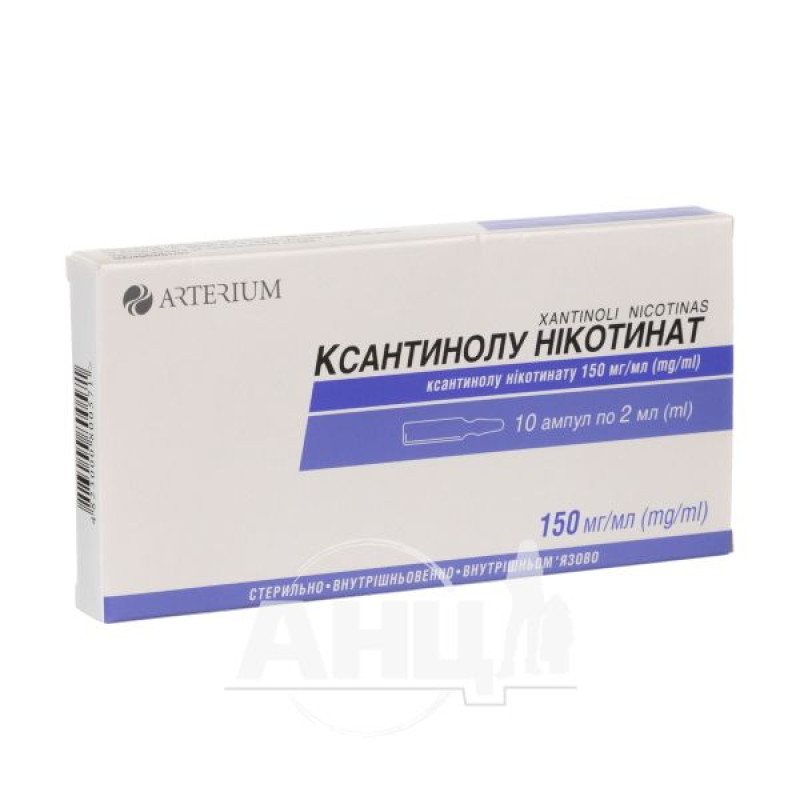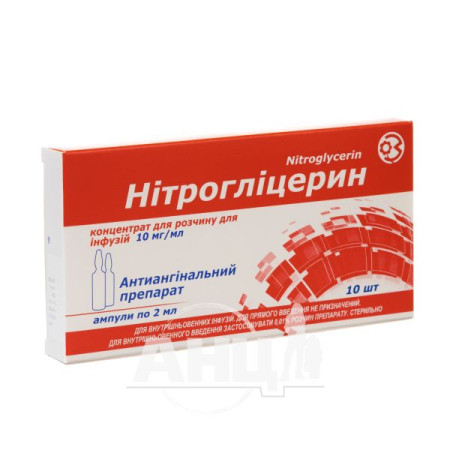Xanthinol nicotinate solution for injection 15% ampoule 2 ml No. 10

Pharmacological properties
Pharmacodynamics. Xanthinol nicotinate has the effects of theophylline and nicotinic acid: the mechanism of action is realized due to the blockade of phosphodiesterase activity, competition with adenosine for receptors, accumulation of cAMP, stimulation of the synthesis of nicotinamide coenzymes and prostanticyclin in the walls of blood vessels. The drug dilates peripheral blood vessels, improves collateral and cerebral blood flow, reduces manifestations of cerebral hypoxia, reduces platelet aggregation, improves microcirculation in the retina, enhances cardiac contractile function, improves metabolic processes in brain tissue in the postoperative period, reduces the level of cholesterol, atherogenic lipoproteins, uric acid, fibrinogen, increases the activity of lipoprotein lipase, enhances fibrinolysis.
Pharmacokinetics. Well absorbed in the digestive tract. In the body, the drug is quickly converted first into theophylline and nicotinic acid, then into their metabolites. Excreted mainly with urine in the form of metabolites. With i / m administration, the effect develops after 5-10 minutes.
Indication
Obliterating atherosclerosis of the vessels of the lower extremities (intermittent claudication), Raynaud's disease, diabetic angiopathy, retinopathy, angioneuropathy, acute thrombophlebitis, acute thrombosis, embolism of blood vessels, migraine, atherosclerotic cerebral circulation disorders, postoperative period after removal of a brain tumor, Meniere's disease, poorly healing trophic ulcers of the lower extremities, retinal vascular diseases, degeneration, retinal detachment.
Application
Tablets. Xanthinol nicotinate tablets are prescribed to adults orally after meals, without chewing. The intake begins with 1 tablet 3 times a day. If necessary, the dose is increased to 2-3 tablets 3 times a day. The tablets are swallowed without chewing. As the condition improves, the dose is reduced to 1 tablet 2-3 times a day. The course of treatment is usually 2 months. In acute disorders of cerebral and peripheral circulation, the injectable form of the drug is preferable. The maximum daily dose is 1800 mg.
Solution for injection. Prescribed for adults IV and IM for acute disorders of cerebral and peripheral circulation. IV (very slowly, since rapid administration may cause dizziness, shortness of breath, chest pain, severe hypotension), administered for acute disorders of peripheral and cerebral circulation. Adults are prescribed IV 2 ml of a 15% solution 1-2 times a day with the transition to IM injection - 2 ml 1-3 times a day. At the same time, 2 tablets of Xanthinol nicotinate are administered orally 3 times a day. In severe cases, IV drip: 10 ml of a 15% solution of the drug (1.5 g) is diluted in 200-500 ml of 5% glucose solution or 0.9% sodium chloride solution. Administered for 1-4 hours up to 4 times a day. The course of treatment is determined individually, approximately - up to 21 days, but there may be a longer therapy. In case of impaired blood supply to tissues, 2 ml of a 15% solution (0.3 g) are administered intramuscularly 1-3 times a day, gradually increasing the dose to 4-6 ml of a 15% solution 2-3 times a day. The course of treatment depends on the course of the disease (up to 2-3 weeks).
In ophthalmological practice in adults, the drug is used by iontophoresis on the eyeball - up to 300 mg 1 time per day. The duration of the first procedure is 15 minutes, the following can be gradually increased to 20-30 minutes. The course of treatment is 15-20 days.
Contraindication
Hypersensitivity to the components of the drug, as well as to theophylline and nicotinic acid; acute and chronic heart failure of II-III degree; myocardial infarction; stenosis of the left atrioventricular valve; acute renal failure; acute hemorrhages; gastric ulcer and duodenal ulcer in the acute stage; glaucoma; pregnancy and breastfeeding. for the drug in tablet form also - children's age.
Side effects
Hypersensitivity reactions: skin rashes (urticaria, erythematous-papular), itching, chills, fever, burning sensation, tingling, hyperemia of the skin in the upper part of the body, especially the neck and head, in rare cases - angioedema;
from the central and peripheral nervous system: headache, dizziness; these symptoms usually disappear after 10-20 minutes and do not require special treatment;
from the digestive tract: diarrhea, anorexia, stomach pain, nausea, vomiting, increased activity of hepatic transaminases and LF;
from the cardiovascular system: arterial hypotension, moderate tachycardia, in some cases it is possible to provoke angina attacks, heart rhythm disturbances, and the development of steal syndrome;
on the part of the respiratory system: in some cases - a feeling of lack of air, shortness of breath;
from the endocrine system: with prolonged use in high doses - decreased glucose tolerance;
others: general weakness, hyperuricemia.
The occurrence of these symptoms upon repeated administration of the drug is a contraindication to continued treatment.
Special instructions
If simultaneous use of cardiac glycosides is necessary to prevent the development of bradycardia and arrhythmia, treatment should be carried out under ECG control.
As a result of the possible increase in transaminase and LF levels with prolonged use of xanthinol nicotinate, caution is required when prescribing it to patients with hepatic or renal insufficiency.
It is prescribed with caution in severe atherosclerosis of the coronary and cerebral vessels, tachysystolic heart rhythm disorders, as well as in elderly patients.
With prolonged use of the drug in high doses, a change in glucose tolerance and biochemical blood parameters may occur, which requires discontinuation of the drug. In patients with diabetes mellitus, it is necessary to determine the level of glucose in the blood more often. Patients with an implanted pacemaker are prescribed the drug in low doses.
The drug should not be used with alcohol and coffee.
Pregnancy and breastfeeding. The drug is not prescribed during pregnancy and breastfeeding.
Children: There is no experience of use in children.
Ability to influence the reaction rate when driving vehicles or working with other mechanisms. Caution should be exercised when driving vehicles and working with other mechanisms, taking into account the possibility of dizziness.
Interactions
To avoid a sharp decrease in blood pressure, the drug should not be combined with antihypertensive agents (α- and β-blockers, sympatholytics, ganglioblockers, ergot alkaloids). The drug is incompatible with strophanthin, MAO inhibitors, alcohol and coffee. When combined with cardiac glycosides, the risk of developing bradycardia and arrhythmia increases. Enhances the anticoagulant effect of heparin, streptokinase, fibrinolysin.
Incompatibility. The drug in solution form is incompatible with strophanthin, MAO inhibitors. Do not mix in the same syringe with other drugs.
Overdose
The drug is low-toxic. Acute overdose may manifest as arterial hypotension (weakness, dizziness), tachycardia, abdominal pain, vomiting. Treatment is symptomatic.
Storage conditions
In the original packaging, protected from light, at a temperature not exceeding 25 °C.
There are no reviews for this product.
There are no reviews for this product, be the first to leave your review.
No questions about this product, be the first and ask your question.




